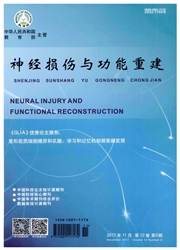

 中文摘要:
中文摘要:
目的 探讨小儿侧脑室周围白质软化症(PVL)的临床特点与MRI影像学表现.方法 对14例PVL的临床资料及磁共振表现进行回顾性分析.结果 PVL的MRI表现包括脑室旁软化灶形成(10例)、侧脑室变形(9例)、脑白质减少(7例)、脑沟及脑裂加深(6例)等,软化灶分布在侧脑室周围及半卵圆中心区,形态大小不一,为长T1、长T2信号、flair为低信号;临床表现为:发育迟缓(6例)、癫痫(7例)、肢体功能障碍(6例)、视力损害(1例)等,7例患儿有缺血缺氧病史.结论 PVL的影像学表现具有一定特征性,MRI是诊断PVL的主要方法.
 英文摘要:
英文摘要:
Objective To explore the clinical symptoms and MRI manifestations of periventricular leukomalacia (PVL) in children. Methods Retrospective analysis were carried out to study the clinical features and MRI manifestations of 14 PVL cases. Results Our MRI results showed changes in white matter, such as periventricular malacia formation( 10), the lateral ventricle deform- ation(9) , white matter quantitative reduction(7) , brain suleus and fissure deepened(6) , these lesions distributed in the periventricular and eentrum semiovale area with different morphology and size, characterized as low signal intensity in T1WI,high in T2WI and low in FI.AIR. The PVI. children expressed growth retardation(6), epilepsy(7), physical dysfunction(6), visual impairment(I), and 7 cases of PVI. children suffered hypoxie isehemic encephalopathy. Conclusion PVI. children have characteristic MRI manifestations, which contribute to early diagnosis of PVL.
 同期刊论文项目
同期刊论文项目
 同项目期刊论文
同项目期刊论文
 Glial Gap Junctional Communication Involvement in Hippocampal Damage After Middle Cerebral Artery Oc
Glial Gap Junctional Communication Involvement in Hippocampal Damage After Middle Cerebral Artery Oc Galectin-1 attenuates astrogliosis-associated injuries and improves recovery of rats following focal
Galectin-1 attenuates astrogliosis-associated injuries and improves recovery of rats following focal 期刊信息
期刊信息
